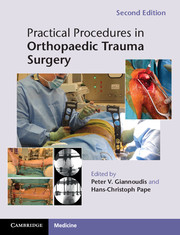Book contents
- Frontmatter
- Dedication
- Contents
- List of Contributors
- Preface
- Acknowledgements
- Part 1 Shoulder girdle
- Part 2 Upper extremity
- Part 3 Pelvis and acetabulum
- Part 4 Lower extremity
- 10 Section I: Extracapsular fractures of the hip
- Section II: Intracapsular fractures of the hip
- 11 Section I: Fractures of the femoral shaft
- 12 Fractures of the patella
- 13 Section I: Fractures of the proximal tibia
- 14 Fractures of the ankle
- 15 Fractures of the foot
- Part 5 Spine
- Part 6 Tendon injuries
- Part 7 Compartments
- Index
Section II: Intracapsular fractures of the hip
Published online by Cambridge University Press: 05 February 2014
- Frontmatter
- Dedication
- Contents
- List of Contributors
- Preface
- Acknowledgements
- Part 1 Shoulder girdle
- Part 2 Upper extremity
- Part 3 Pelvis and acetabulum
- Part 4 Lower extremity
- 10 Section I: Extracapsular fractures of the hip
- Section II: Intracapsular fractures of the hip
- 11 Section I: Fractures of the femoral shaft
- 12 Fractures of the patella
- 13 Section I: Fractures of the proximal tibia
- 14 Fractures of the ankle
- 15 Fractures of the foot
- Part 5 Spine
- Part 6 Tendon injuries
- Part 7 Compartments
- Index
Summary
Indications
Non-displaced fractures of neck of femur (Garden grade I, II).
Displaced fractures of the femoral neck in a physiologically/biologically young patient after adequate reduction has been obtained.
Preoperative planning
Clinical assessment
Groin pain localized in the affected hip side – radiation of pain to the knee.
The limb is shortened and externally rotated.
Assess and document the neurovascular status of the leg.
In young patients careful examination for other injuries must be made, as femoral neck fractures are the result of high-energy trauma.
Perform a complete medical examination in elderly patients.
Radiological assessment
Anteroposterior and lateral radiographic views of the afected hip (Fig. 10.3.1).
Anteroposterior radiograph of the pelvis.
Evaluate head retroversion and posterior comminution.
Assess the primary, secondary compression lines and the tension trabeculae on radiographs (Singh).
Assess the ‘verticality’ of the fracture using the Pauwels classiication.
An MRI or a CT is indicated when physical history and/or signs are suggestive of a fracture and this is not clear on the plain radiographs.
- Type
- Chapter
- Information
- Practical Procedures in Orthopaedic Trauma Surgery , pp. 260 - 276Publisher: Cambridge University PressPrint publication year: 2014



